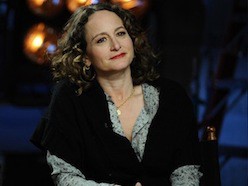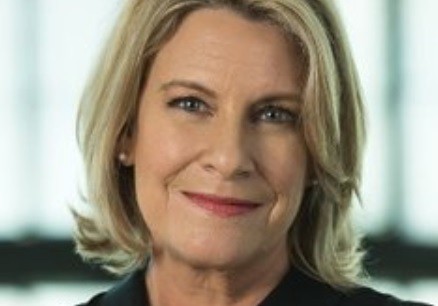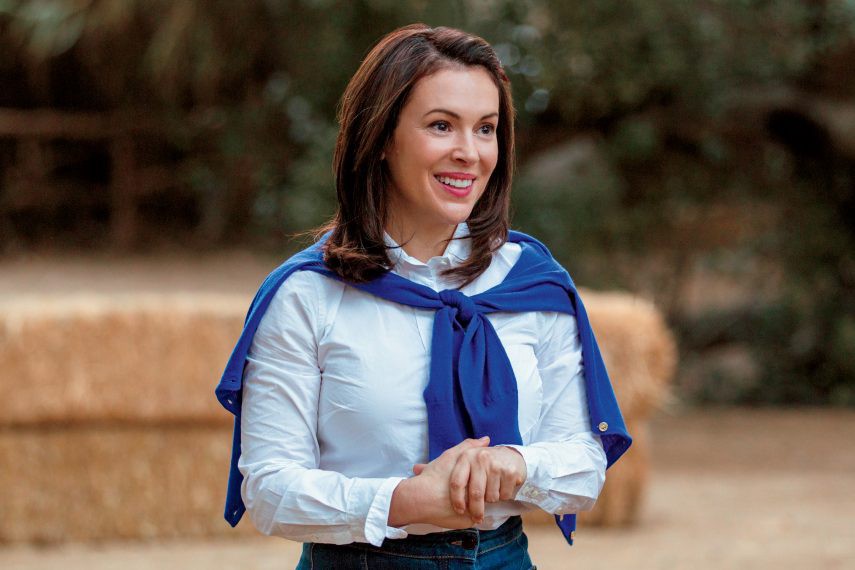This weekend, The Hunger Games: Catching Fire became the highest-grossing November release ever with a box-office take of $161 million — $30 million over its production budget. Though star Jennifer Lawrence has been the face of Catching Fire, the blockbuster feminist franchise is the brainchild of an even more powerful woman working behind the scenes: producer Nina Jacobson.
For almost a decade, Jacobson was the president of Buena Vista Motion Pictures, a Disney subsidiary studio. In 2007, she created her own production house, Color Force, under which she’s produced the Hunger Games quadrilogy and another female-centric film, the Anne Hathaway vehicle One Day. Jacobson spoke with Women and Hollywood about her favorite scenes in Catching Fire, the similarities between Lawrence and Katniss, the controversies surrounding some questionable Hunger Games promotional tie-ins, and the ongoing difficulties of convincing men to make movies about women.
Congratulations on another awesome film.
I’ve seen it so many times, and if anything, [the more that I watch it, the more it] gets me. I get all weepy.
Why do you think you have such a strong reaction to it?
First of all, I just feel for these characters so much. There are a few moments that really get to me [mild spoilers]: when Katniss goes to District 11 and she speaks to Rue’s family; when the people of 11 acknowledge her and the way it all goes so bad; when Peeta says, “No one needs me,” and she says, “I need you,” and it’s her first real romantic kiss; and when she doesn’t get to say goodbye to her sister. And then the moment when she transforms into the Mockingjay, and she looks at Cinna, and you know that Cinna is being targeted and yet she’s owning that moment — that gets to me. Those things really stir me. You’re watching these characters carrying the pain and the weight with them — the burden of what they’ve been through. Also, I think a lot about our soldiers — what they carry with them after a decade of war, and that gets to me.
In the press notes, you said that you wanted this film to be every bit as ambitious as the first one. Was the budget of this film greater than the first one?
Yes, it was. It was greater largely because we went from three locations in the first movie to 33 in this one. We had a lot more ground to cover. They go to all the different districts. They spend a lot of time in The Capitol — the Capitol parties, which include the extravagance of The Capitol. Then we have the arena. The arena [in the first film] is man-made. It feels, and was, largely a naturalistic arena where the combat was between the participants, as opposed to the arena as their opponent in this film. Creating the visual effects that allowed the arena to be a character, and the opponent to these tributes, obviously required more visual effects. We also, of course, had to pay our actors more money this time around, deservedly. So yes, it was a more expensive movie, but by necessity.
It seems to me, and maybe I’m wrong, that this is probably the highest budget live-action movie with a female lead ever made.
That’s a good question. I guess you could look at Ripley and the Alien movies, and what those cost in their day, so I don’t know apples-to-apples how they would compare. But you might be right.
You watch this character of Katniss being a reluctant leader and yet people look to her, and she’s become a role model not only to people in the movie, but to people in real life, especially when we don’t see a lot of really strong women in film. I’ve seen Jennifer Lawrence talk about her relationship with young people who see the movie. What’s that responsibility like, to portray a strong young woman onscreen?
I think it’s one of the things that I most respect about Jen. I do think that she understands the role that she has sort of been forced into, in the same way that Katniss has been. There are so many parallels. I particularly appreciate the fact that she takes a real point of view about women and girls and their bodies and won’t play the game of obsessing about weight. She’s just a normal, fun, goofy girl who eats what she wants. She sets an example in that way that I really appreciate — by just being candid, and honest.
My daughter is thirteen and really looks up to Jen. I feel like that’s a girl whose worthy of you looking up to her. My daughter also loves all the little the clips. Like, here’s Jen spilling her mints at a press conference, and look, here’s Jen falling down the stairs. They appreciate how human she is, and how okay she is with just being a regular girl. No exaggeration and no airbrushing — she’s quite a regular girl. So unfull of herself.
I’ve been reading about some of the controversy on the make-up merchandising, especially from young women, thinking that it contradicts the message of the movie. I’m wondering if you have any comments on the merchandising campaigns and the tie-ins.
We talked about this a lot from the beginning. Suzanne Collins and [Lionsgate’s Chief Marketing Officer] Tim Palen have a very, very open relationship — communicative and candid. Tim has always said, Above all, do no harm. I think that what we found was that there was a way to have this sort of meta campaign: a campaign for the Capitol.
The way that I look at it is, we as filmmakers always try in our storytelling [to] identify with the districts. Katniss represents the districts, the poorest of the poor. As a nation, we have plenty of Capitol in us. That gap that exists between the districts and The Capitol — between the 99 % and the 1% — is so much a part of the way that we live. The Capitol Couture Campaign and the campaigns that sort of play on all the excess of The Capitol are, in their own way, reminders not to let ourselves off the hook. These books are dystopic fiction but we’re talking about us. I feel that the campaign [propels discussion about] Capitol values into the mainstream conversation. It’s also very worthwhile for us all to be reminded that we’re incriminated in that side of things too.
You and I can have that conversation because we’re adults, but girls respond to things differently. They don’t have the experience that we do. What I’m seeing are comments about targeting young women. That’s why I wanted to ask you that question. But on the other hand, this is a huge opportunity and you can’t not take it because this is really one of the first big girl-centric events.
We also have women who worked on this movie who helped create the aesthetic, between Ve Neill and Trish Somerville, who did the makeup and wardrobe respectively, two amazing women and incredible artists. Their work is extraordinary. Getting to see some of their work in the marketplace is another side of the equation. The readers of these books and the consumers — we never talk down to them. We give them the benefit of the doubt, that they get it. So I hope that they do get it.
As a producer, do you notice things changing? Now that you have a movie about a powerful female character, do you feel that people are getting it a little more?
I sure hope so. Working at Disney, we always knew that women were incredible drivers in the marketplace in terms of what movies families go to see, what movies couples go to see. Women have an enormous voice in the marketplace. I certainly hope that that’s being seen to a greater and greater degree.
Also, there’s always been a sort of bullshit message out there that was conveyed as supposed conventional wisdom: that women will root for a man as a protagonist and identify with him, but men won’t root for or identify with a woman protagonist. I think that’s a whole lot of B.S. and I hope that this movie has helped show that it’s a bunch of B.S.
Is that perpetuated by people who want to keep making movies about men?
Yeah.
I don’t think that actual audiences think like that, but it’s the message that I hear. I think people want us to believe that men won’t go see movies about women, but women will see movies about men.
Yeah. It’s silly.
What did you learn from the first film that you took into the second film?
That you can never go wrong when you stay rooted in Katniss’ point of view. We obviously expanded the world of these [books]. That’s the opportunity that the adaption process allows us, which is to see things that Katniss couldn’t see in the book. She doesn’t know what’s going on behind the scenes between Plutarch and Snow, but we get to see that. As the movies go on, we see more and more of what she can’t see in the books. But at the same time, what we always find is that the emotional truth of this movie lies in Katniss’s perspective and in her story. What we’ve learned is, stay with Katniss — that’s where the truth will always be. You’re always on the right side of things when you’re with her.
It means so much to have someone like you shepherding this through. I trust you. You have a vision and you get it. I really feel like this movie is moving the conversation forward. The next thing I want to understand is why we’re only comfortable with young women in these kinds of leads. When are we going to be more comfortable with older women, those in their 20s, 30s, and above?
Well, that’s a good question. I hope that we’re getting there. We have phenomenal women out there. You’ll see that Julianne Moore’s role in Mockingjay [the third installment] is much bigger in the movie than it is in the book. Again, in the book, you can only see it from Katniss’ point of view. There are a lot of scenes that Katniss wasn’t a part of that we get to see in the film. Even when we go away from Katniss, it’s always still about her. I think — I hope — that what you’re saying is true, and that we will see more and more of that, because we have phenomenal women out there who are more than capable of carrying these movies, and I know that I myself would like to see more of them.
Well, we wouldn’t have Divergent had we not had Hunger Games. It’s all a progression, I think.
I hope so.







